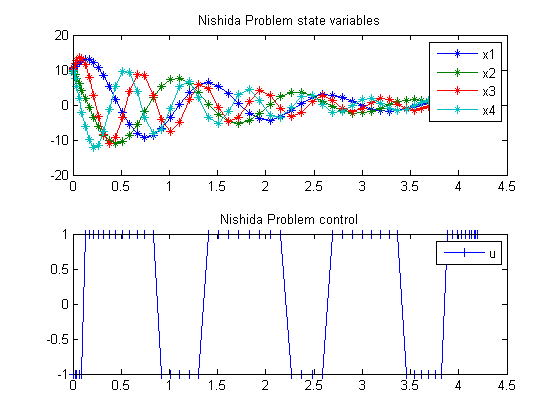Nishida problem
Second-order sensitivities of general dynamic systems with application to optimal control problems. 1999, Vassilios S. Vassiliadis, Eva Balsa Canto, Julio R. Banga
Case Study 6.3: Nishida problem
Contents
Problem description
This case study was presented by Nishida et al. (1976) and it is posed as follows:
Minimize:

subject to:





with the initial conditions: x(i) = 10, i=1,..,4 and with t_f = 4.2.
% Copyright (c) 2007-2010 by Tomlab Optimization Inc.
Problem setup
toms t p = tomPhase('p', t, 0, 4.2, 60); setPhase(p); tomStates x1 x2 x3 x4 tomControls -integer u % Initial guess x0 = {icollocate({ x1 == 10-10*t/4.2; x2 == 10-10*t/4.2 x3 == 10-10*t/4.2; x4 == 10-10*t/4.2}) collocate(u == 0)}; % Box constraints cbox = {icollocate({ -15 <= x1 <= 15; -15 <= x2 <= 15 -15 <= x3 <= 15; -15 <= x4 <= 15}) -1 <= collocate(u) <= 1}; % Boundary constraints cbnd = initial({x1 == 10; x2 == 10 x3 == 10; x4 == 10}); % ODEs and path constraints ceq = collocate({ dot(x1) == -0.5*x1+5*x2 dot(x2) == -5*x1-0.5*x2+u dot(x3) == -0.6*x3+10*x4 dot(x4) == -10*x3-0.6*x4+u}); % Objective objective = final(x1)^2+final(x2)^2+final(x3)^2+final(x4)^2;
Solve the problem
options = struct; options.name = 'Nishida Problem'; options.solver = 'cplex'; solution = ezsolve(objective, {cbox, cbnd, ceq}, x0, options); t = subs(collocate(t),solution); x1 = subs(collocate(x1),solution); x2 = subs(collocate(x2),solution); x3 = subs(collocate(x3),solution); x4 = subs(collocate(x4),solution); u = subs(collocate(u),solution);
Problem type appears to be: miqp
Starting numeric solver
===== * * * =================================================================== * * *
TOMLAB - Tomlab Optimization Inc. Development license 999001. Valid to 2011-02-05
=====================================================================================
Problem: --- 1: Nishida Problem f_k 1.004741515225467100
sum(|constr|) 0.000000000061595707
f(x_k) + sum(|constr|) 1.004741515287062700
f(x_0) 0.000000000000000000
Solver: CPLEX. EXIT=0. INFORM=102.
CPLEX Branch-and-Cut MIQP solver
Optimal sol. within epgap or epagap tolerance found
FuncEv 872 GradEv 872
CPU time: 0.687500 sec. Elapsed time: 0.703000 sec.
Plot result
subplot(2,1,1) plot(t,x1,'*-',t,x2,'*-',t,x3,'*-',t,x4,'*-'); legend('x1','x2','x3','x4'); title('Nishida Problem state variables'); subplot(2,1,2) plot(t,u,'+-'); legend('u'); title('Nishida Problem control');
